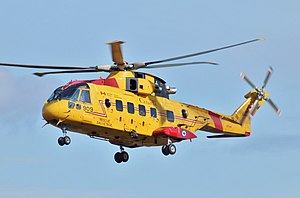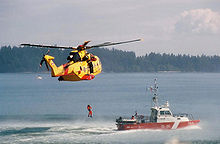
The Boeing Vertol CH-46 Sea Knight is an American medium-lift tandem-rotor transport helicopter powered by twin turboshaft engines. It was designed by Vertol and manufactured by Boeing Vertol following Vertol's acquisition by Boeing.
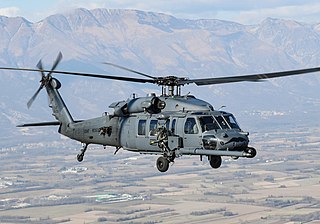
The Sikorsky MH-60/HH-60 Pave Hawk is a four-blade, twin-engine, medium-lift utility military helicopter manufactured by Sikorsky Aircraft. It is a derivative of the UH-60 Black Hawk and incorporates the US Air Force PAVE electronic systems program. The HH-60/MH-60 is a member of the Sikorsky S-70 family.
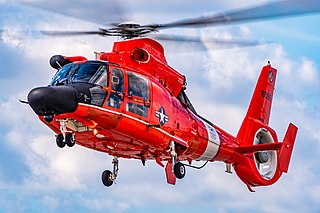
The Eurocopter MH-65 Dolphin is a twin-engined helicopter operated by the United States Coast Guard (USCG) for medevac-capable search and rescue (SAR) and armed Airborne Use of Force missions. It is a variant of the French-built Eurocopter AS365 Dauphin.

The Sikorsky SH-3 Sea King is an American twin-engined anti-submarine warfare (ASW) helicopter designed and built by Sikorsky Aircraft. A landmark design, it was one of the first ASW rotorcraft to use turboshaft engines.

The Westland WS-61 Sea King is a British licence-built version of the American Sikorsky S-61 helicopter of the same name, built by Westland Helicopters. The aircraft differs considerably from the American version, with Rolls-Royce Gnome engines, British-made anti-submarine warfare systems and a fully computerised flight control system. The Sea King was primarily designed for performing anti-submarine warfare (ASW) missions. A Sea King variant known as the Commando was developed by Westland to serve as a troop transport.

The AgustaWestland AW101 is a medium-lift helicopter in military and civil use. First flown in 1987, it was developed by a joint venture between Westland Helicopters in the United Kingdom and Agusta in Italy in response to national requirements for a modern naval utility helicopter. Several operators, including the armed forces of Britain, Denmark, and Portugal, use the name Merlin for their AW101 aircraft. It is manufactured at factories in Yeovil, England, and Vergiate, Italy. Licensed assembly work has also taken place in Japan and the United States.

The Sikorsky CH-124 Sea King is a twin-engined anti-submarine warfare (ASW) helicopter designed for shipboard use by Canadian naval forces, based on the US Navy's SH-3 Sea King. Most CH-124s were assembled in Quebec by United Aircraft of Canada. The CH-124 served with the Royal Canadian Navy (RCN) and Canadian Armed Forces from 1963 to 2018.

The Sikorsky CH-148 Cyclone is a twin-engine, multi-role shipborne helicopter developed by the Sikorsky Aircraft Corporation for the Canadian Armed Forces. A military variant of the Sikorsky S-92, the CH-148 is designed for shipboard operations and replaced the CH-124 Sea King, which was in Canadian Armed Forces operation from 1963 to 2018.

The Sikorsky S-92 is an American twin-engine medium-lift helicopter built by Sikorsky Aircraft for the civil and military helicopter markets. The S-92 was developed from the Sikorsky S-70 helicopter and has similar parts such as flight control and rotor systems.

Canadian Forces Base Comox, commonly referred to as CFB Comox or 19 Wing, is a Canadian Forces Base located 2.5 nautical miles north northeast of Comox, Vancouver Island, British Columbia. It is primarily operated as an air force base by the Royal Canadian Air Force (RCAF) and is one of two bases in the country using the CP-140 Aurora anti-submarine/maritime patrol and surveillance aircraft. Its primary RCAF lodger unit is 19 Wing, commonly referred to as 19 Wing Comox.
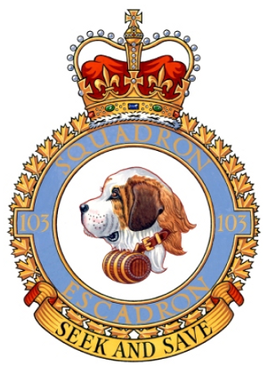
103 Search and Rescue Squadron of the Royal Canadian Air Force is a search and rescue unit based at 9 Wing Gander on the Canadian island of Newfoundland. The squadron is responsible for a large area covering the offshore waters of Canada's Exclusive Economic Zone in the Atlantic Ocean and inland areas in the Maritimes, Newfoundland and Labrador, and parts of Eastern Quebec. The squadron operates three AgustaWestland CH-149 Cormorant helicopters.

442 Transport and Rescue Squadron is a Royal Canadian Air Force tactical transport and search and rescue unit based at Canadian Forces Base (CFB) Comox in British Columbia. The squadron flies six CC-295 Kingfisher aircraft, replacing six CC-115 Buffalo STOL aircraft, which have been retired as of 2020, and five AgustaWestland CH-149 Cormorant rescue helicopters. One of each is on constant readiness to deploy in response to distress calls in the Victoria Search and Rescue Region, which includes most of British Columbia and the territory of Yukon as well as 560,000 square kilometres in the Pacific Ocean, up to 600 nautical miles (1,100 km) offshore. The squadron also serves as the operational training unit for the CH-149 Cormorant helicopter and CC-295 Kingfisher aircraft.

The Lockheed Martin VH-71 Kestrel was a variant of the AgustaWestland AW101 that was being manufactured to replace the United States Marine Corps' Marine One U.S. Presidential transport fleet. Originally marketed for various competitions as the US101, it was developed and manufactured in the US by a consortium headed by Lockheed Martin, consisting of Lockheed Martin Systems Integration – Owego (LMSI), AgustaWestland and Bell Helicopter.

The General Electric T700 and CT7 are a family of turboshaft and turboprop engines in the 1,500–3,000 shp (1,100–2,200 kW) class.

The Bell UH-1N Twin Huey is a medium military helicopter designed and produced by the American aerospace manufacturer Bell Helicopter. It is a member of the extensive Huey family, the initial version was the CUH-1N Twin Huey, which was first ordered by the Canadian Forces in 1968.
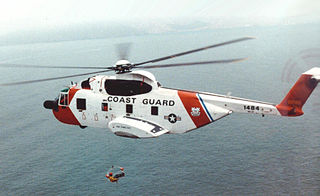
The Sikorsky S-61R is a twin-engine helicopter used in transport or search and rescue roles. A developed version of the S-61/SH-3 Sea King, the S-61R was also built under license by Agusta as the AS-61R. The S-61R served in the United States Air Force as the CH-3C/E Sea King and the HH-3E Jolly Green Giant, and with the United States Coast Guard as the HH-3F, nicknamed "Pelican".

The Eurocopter EC725 Caracal, now called Airbus Helicopters H225M, is a long-range tactical transport military helicopter developed from the Eurocopter AS532 Cougar for military use. It is a twin-engined aircraft and can carry up to 28 seated troops along with two crew, depending on customer configuration. The helicopter is marketed for troop transport, casualty evacuation, and combat search and rescue duties, and is similar to the civilian EC225 Super Puma.

Canadian Armed Forces Search and Rescue is the collective name used to refer to search and rescue (SAR) resources and operations within the Canadian Armed Forces (CAF). The Royal Canadian Navy (RCN) and Royal Canadian Air Force (RCAF) are jointly responsible for Canada’s SAR operations.

VXX, officially the Presidential Helicopter Replacement Program, is a procurement program to replace aging Marine One helicopters that transport the President of the United States. The current VH-3 helicopters have aging airframes, having entered service with United States Marine Corps Marine Helicopter Squadron One (HMX-1) in 1963. The VH-3D replaced the VH-3A by 1976. The smaller VH-60N entered service in 1987. On 7 May 2014, it was announced that the Sikorsky VH-92 had won the VXX competition.
